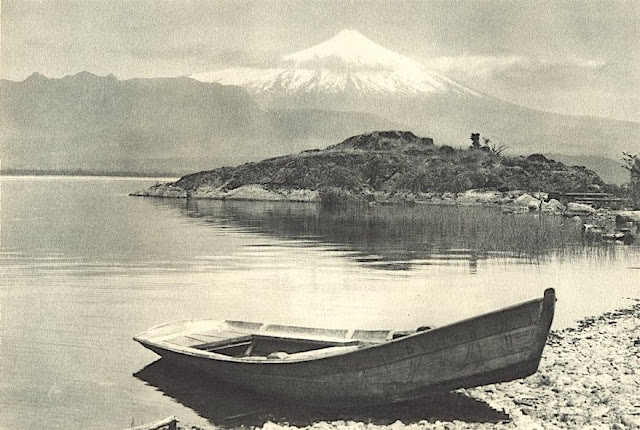

ALEXANDER VON HUMBOLDT (1769-1859
El Chimborazo (6,263 m -20,548 ft)
Ecuador
1. Coloured aquatint by F. Arnold after J. Gmelin after Alexander von Humboldt.
2. Original print in Vista del Chimborazo y del Carguairazo from the book Vistas de las cordilleras y monumentos de los pueblos indígenas de América by Alexander von Himboldt and Aimé Bonpland, 1816
The mountain
El Chimborazo (6,263 m -20,548 ft) is a currently inactive stratovolcano
in the Cordillera Occidental range of the Andes ans the highest mountain
in Ecuador and the Andes north of Peru ; it is higher than any more
northerly summit in the Americas. Chimborazo is not the highest mountain
by elevation above sea level, but its location along the equatorial
bulge makes its summit the farthest point on the Earth's surface from
the Earth's center.
Chimborazo is at the main end of the Ecuadorian Volcanic Arc, north west
of the town of Riobamba. Chimborazo is in la Avenida de los Volcanes
(the Avenue of Volcanoes) west of the Sanancajas mountain chain.
Carihuairazo, Tungurahua, Tulabug, and El Altar are all mountains that
neighbor Chimborazo. The closest mountain peak, Carihuairazo, is 5.8 mi
(9.3 km) from Chimborazo. There are many microclimates near Chimborazo,
varying from desert in the Arenal to the humid mountains in the
Abraspungo valley.
Its last known eruption is believed to have occurred around A.D. 550.
Until the beginning of the 19th century, it was thought that Chimborazo
was the highest mountain on Earth (measured from sea level), and such
reputation led to many attempts on its summit during the 17th and 18th
centuries.
In 1746, the volcano was explored by French academicians from the
French Geodesic Mission. Their mission was to determine the sphericity
of the Earth. Their work along with another team in Lapland established
that the Earth was an oblate spheroid rather than a true sphere. They
did not reach the summit of Chimborazo.
In 1802, during his expedition to South America, Baron Alexander von
Humboldt, accompanied by Aimé Bonpland and the Ecuadorian Carlos
Montufar, tried to reach the summit. From his description of the
mountain, it seems that before he and his companions had to return
suffering from altitude sickness they reached a point at 5,875 m, higher
than previously attained by any European in recorded history. (Incans
had reached much higher altitudes previously; see Llullaillaco). In
1831, Jean-Baptiste Boussingault and Colonel Hall reached a new "highest
point", estimated to be 6,006 m.
El Carguairazo is an ancient collapsed volcano (to the right of Chimborazo on the engraving). The muddy flood which, in 1698, covered 18 square leagues of land, was not the result of an eruption proper. When the Carguairazo collapsed, the waters that it concealed in its breast rushed into the plain with impetuosity, and caused the disasters of which the historians of America speak.
The cartographer
Friedrich Wilhelm Heinrich Alexander von Humboldt was a Prussian geographer, naturalist, explorer, and influential proponent of Romantic philosophy and science. He was the younger brother of the Prussian minister, philosopher, and linguist Wilhelm von Humboldt (1767–1835). Humboldt's quantitative work on botanical geography laid the foundation for the field of biogeography. Humboldt's advocacy of long-term systematic geophysical measurement laid the foundation for modern geomagnetic and meteorological monitoring.
Between 1799 and 1804, Humboldt travelled extensively in Latin America, exploring and describing it for the first time from a modern scientific point of view. His description of the journey was written up and published in an enormous set of volumes over 21 years. Humboldt was one of the first people to propose that the lands bordering the Atlantic Ocean were once joined (South America and Africa in particular). Humboldt resurrected the use of the word cosmos from the ancient Greek and assigned it to his multi-volume treatise, Kosmos, in which he sought to unify diverse branches of scientific knowledge and culture. This important work also motivated a holistic perception of the universe as one interacting entity.
On their way back to Europe from Mexico on their way to the United States, Humboldt and his fellow scientist Aimé Bonpland stopped in Cuba for a While. After their first stay in Cuba of three months they returned the mainland at Cartagena de Indias (now in Colombia), a major center of trade in northern South America. Ascending the swollen stream of the Magdalena River to Honda and arrived in Bogotá on July 6, 1801 where they met Spanish botanist José Celestino Mutis, the head of the Royal Botanical Expedition to New Granada, staying there until September 8, 1801. Mutis was generous with his time and gave Humboldt access to the huge pictorial record he had compiled since 1783. Humboldt had hopes of connecting with the French sailing expedition of Baudin, now finally underway, so Bonpland and Humboldt hurried to Ecuador. They crossed the frozen ridges of the Cordillera Real, they reached Quito on 6 January 1802, after a tedious and difficult journey.
Their stay in Ecuador was marked by the ascent of Pichincha and their climb of Chimborazo, where Humboldt and his party reached an altitude of 19,286 feet (5,878 m). This was a world record at the time, but a thousand feet short of the summit. Humboldt's journey concluded with an expedition to the sources of the Amazon en route for Lima, Peru.
At Callao, the main port for Peru, Humboldt observed the transit of Mercury. On 9 November and studied the fertilizing properties of guano, rich in nitrogen, the subsequent introduction of which into Europe was due mainly to his writings.
___________________________________________
2019 - Wandering Vertexes...
by Francis Rousseau




















